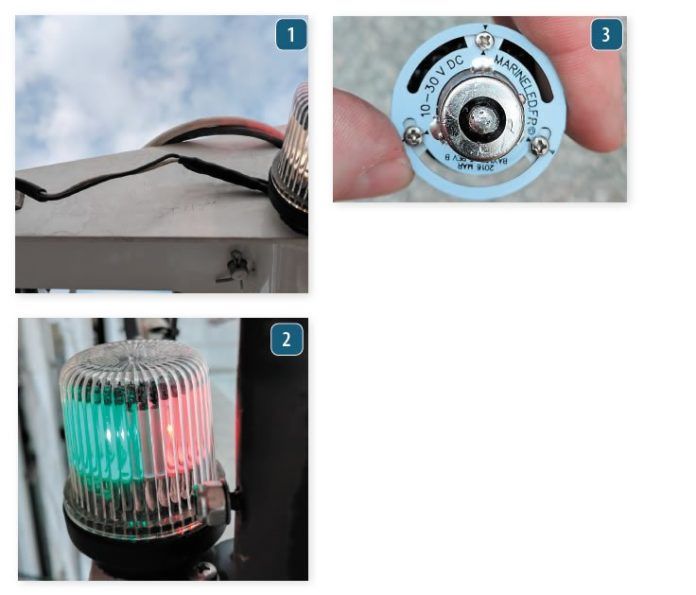The cost of masthead tricolor navigation lights, a safety improvement many sailors add to their boats, involves expense beyond the fixture itself such as a switch on the DC panel, additional wire to snake from the panel to the masthead, through-deck fitting, and labor.
Additionally, you may need to move the existing anchor light fixture to provide the tri-color a good unobstructed view. Our past test (See Practical Sailor Tracks Down the Best Marine LED, February 2010 online) offers several recommended tri-color options, but what if you could convert your existing clear anchor light into a tri-color fixture using a tri-color LED bulb?
Photos by Dan Corcoran

Marinebeam offers just such a bulb, in their LED tri-color and anchor light combination bulb ($87), which we installed into the housing for a standard Hella anchor light (# 598458), specified for boats under 12 meters. We confirmed the bulbs claimed visibility, looked for interference with our VHF radio (none found), tried it for a week, and came out impressed-but with two installation recommendations.
The bulb is available in two bayonet styles designed to drop into many existing fixtures. Once you have access to the masthead, the bulb replacement can be done in minutes, however you might have to relocate the housing for all the sectors to be visible.
The bulb is controlled at the DC panel switch. By pulsing the on-off switch one, two, or three times as you turn it on, it becomes an anchor light, tri-color light, or an SOS strobe. The bulb also has a built in light sensor that turns off the anchor light function from dusk to dawn. Unfortunately it is hard to check what mode the light is in from deck, but Marinebeam is developing an indicator for the panel switch.
Prior to fastening your new new tricolor in place, PS recommends you double check two things.
Look for objects like thick antennae or a wind instrument pole that may obstruct the bulb and require your anchor light or the object be moved to minimize obstruction.
If your masthead base is wider than your fixture, consider raising the fixture so that the light is visible from your sailboat deck.
The main concern we have with this hybrid approach to mast light is that the new light and fixture do not comply with any nav light standards. The existing standards only apply to fixtures and lights that have been tested together as one unit. Because weve introduced a new light to a lens designed for a different bulb, we have no objective measure of the luminosity-other than to check ourselves. Marinebeam points out that recreational boats in the U.S. are not technically bound to luminosity standards, but it is comforting to know that our lights are up to snuff.
The manufacturer states that the bulb itself meets all of the COLREG requirements as a stand-alone bulb. This includes COLREG specs for color coordinates, sector angle, intensity, vertical angle (for sailboats). Testing was carried out by Ensta Bretagne (Britanny) in France, the official test lab for Bureau Veritas for navigational lighting. The bulb meets the EN EMC (electromagnetic compatibility) norms EN55022, EN61547, and EN60945, as well as CE EMC directives for radiated and conducted emissions.
Remember, only use a tri-color while sailing with your other navigation lights turned off. When you are displaying a steaming light while under engine power, you should show the conventional port-starboard-stern running lights (not those mounted on the masthead), and only one set of nav lights can be on at a time.







































